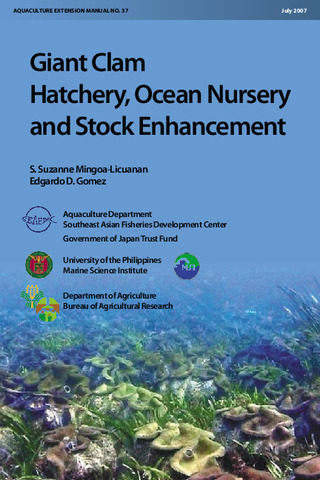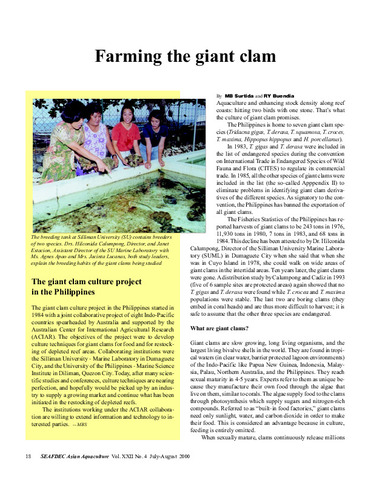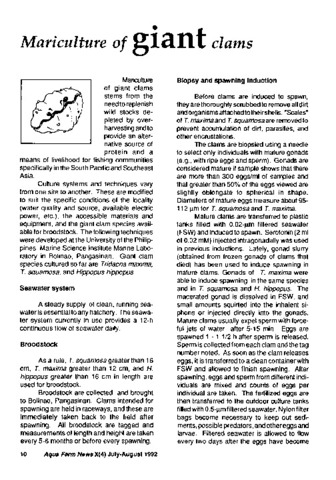| dc.contributor.author | Lebata-Ramos, M. Junemie Hazel L. | |
| dc.contributor.author | Okuzawa, Koichi | |
| dc.contributor.author | Maliao, Ronald J. | |
| dc.contributor.author | Abrogueña, Jeff Bogart R. | |
| dc.contributor.author | Dimzon, Mark Darwin N. | |
| dc.contributor.author | Doyola-Solis, Ellen Flor C. | |
| dc.contributor.author | Dacles, Terence U. | |
| dc.date.accessioned | 2014-05-28T09:53:45Z | |
| dc.date.available | 2014-05-28T09:53:45Z | |
| dc.date.issued | 2010 | |
| dc.identifier.citation | Lebata-Ramos, M. J. H. L., Okuzawa, K., Maliao, R. J., Abrogueña, J. B. R., Dimzon, M. D. N., Doyola-Solis, E. F. C., & Dacles, T. U. (2010). Growth and survival of hatchery-bred giant clams (Tridacna gigas) in an ocean nursery in Sagay Marine Reserve, Philippines. Aquaculture International, 18(1), 19-33. | en |
| dc.identifier.issn | 0967-6120 | |
| dc.identifier.uri | http://hdl.handle.net/10862/2104 | |
| dc.description.abstract | To restore the diminishing population of the giant clam Tridacna gigas in Sagay Marine Reserve (SMR), Negros Occidental, central Philippines, two size classes [8- and 10-cm shell length (SL)] of hatchery-bred T. gigas were reared in an adjacent ocean nursery for restocking to Carbin Reef later upon reaching grow-out size of ≥20 cm SL. Growth rates did not significantly differ for both sizes and were on average 0.67 cm month−1. However, survival after 382 days of rearing T. gigas was significantly higher in the 10-cm SL clams than the 8-cm SL clams (96 and 83%, respectively). For future restocking projects, the use of 8-cm SL clams is recommended because the lower survival of this size class is compensated by its cheaper price. While rearing the clams to attain grow-out size, the population of wild clams (Family Tridacnidae) in Carbin Reef was assessed using ten 50 × 2-m belt transects. Four species of tridacnid clams have been recorded: Hippopus hippopus, Tridacna crocea, T. maxima>, and T. squamosa. T. crocea comprised 12.5–93.9% of all the clams observed in all ten transects. There was a significant difference in clam density between species (ANOVA, F = 6.94, P < 0.001), with T. crocea having the highest density. Living T. gigas were absent, but presence of dead shells was indicative of its presence in the reef in the past. It can be expected that the release of hatchery-bred T. gigas juveniles in Carbin Reef could provide future breeders that will repopulate this reef and the adjacent reef communities. | en |
| dc.description.sponsorship | This project was funded by the SEAFDEC/AQD (Budget Code 5205-T-RD-FS0106) and the Government of Japan Trust Fund (Budget Code 8100-T-FD-FS0106). Field work in Carbin Reef was assisted by Joemel Sumbing, Silverio Tibudan of SEAFDEC/AQD, SMR staff, Sagay City LGU and the Bantay Dagat. The map was drawn by Isidro Tendencia of SEAFDEC/AQD. The manuscript was reviewed by two anonymous reviewers. | en |
| dc.language.iso | en | en |
| dc.publisher | European Aquaculture Society | en |
| dc.subject | Hippopus hippopus | en |
| dc.subject | Tridacna crocea | en |
| dc.subject | Tridacna gigas | en |
| dc.subject | Tridacnidae | en |
| dc.subject | Philippines | en |
| dc.subject | Philippines, Negros I., Negros Occidental | en |
| dc.subject | assessment | en |
| dc.subject | Giant clam | en |
| dc.subject | Ocean nursery | en |
| dc.title | Growth and survival of hatchery-bred giant clams (Tridacna gigas) in an ocean nursery in Sagay Marine Reserve, Philippines | en |
| dc.type | Article | en |
| dc.citation.volume | 18 | |
| dc.citation.issue | 1 | |
| dc.citation.spage | 19 | |
| dc.citation.epage | 33 | |
| dc.citation.journalTitle | Aquaculture International | en |
| dc.subject.asfa | clam culture | en |
| dc.subject.asfa | growth rate | en |
| dc.subject.asfa | hatcheries | en |
| dc.subject.asfa | mariculture | en |
| dc.subject.asfa | marine parks | en |
| dc.subject.asfa | nursery grounds | en |
| dc.subject.asfa | Oceans | en |
| dc.subject.asfa | population density | en |
| dc.subject.asfa | reefs | en |
| dc.subject.asfa | restocking | en |
| dc.subject.asfa | shells | en |
| dc.subject.asfa | stocking (organisms) | en |
| dc.subject.asfa | survival | en |
| dc.identifier.essn | 1573-143X | |
| dc.identifier.doi | 10.1007/s10499-009-9272-4 | |



